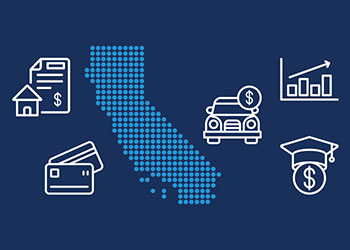- By:
- Category:

Berkeley, CA, April 4, 2023 — A new Data Point released today by the nonpartisan California Policy Lab (CPL) shows across-the-board increases in auto lending in California during the past ten years. There has been a 36% increase in the number of Californians who have auto loans, and the size, length, and monthly payments for these loans have all grown considerably as well.
“Monthly payments on new loans are up a whopping 48% since 2012,” explains co-author Evan White, the Executive Director of the California Policy Lab at UC Berkeley. “These trends are especially troubling given the expiration of pandemic-era income supports that helped prop up the balance sheets of low and middle-income households. This doesn’t bode well for Californians, especially when you consider how important having a car is for work, school, and household errands.”
CPL also published updated research on Californians’ financial health to the California Consumer Credit Dashboard, including new charts focused on foreclosures, auto repossessions, and credit card usage, as well as a map of delinquency trends by county. This new version of the Dashboard includes 9 longitudinal charts for 6 types of debt (auto, credit card, home equity, mortgage, student, and other) and collections. The figures can be sorted by 7 age groups, 9 economic regions, and now by 5 credit ratings. The Dashboard data generally spans from Q1 2004 through Q4 2022. This Data Point uses nominal dollars, but the California Credit Dashboard includes an option to adjust for inflation.
Key Findings on Auto Loans (for new or used cars)
● The average new auto loan in California is now over $34,000, a full $7,300 more than it was just 3 years ago.
● The average monthly payment on a new auto loan rose 48% over the last decade, from $405 in Q4 2012 to $598 in Q4 2022.
● The average length of new auto loans has increased from 60 months in 2012 to 68 months in 2022.
● Delinquencies are starting to increase, from a low of about 1.5% in mid-2021 to 2.7% at the end of 2022. Delinquency rates are highest among younger consumers, with the delinquency rate for Gen Z (ages 18-26) at 4.7%.
Key Findings on Californians’ Financial Health
• Since about mid-2021, there has been a marked increase in borrowers using more of their available credit on their credit cards. As of December 2022, deep-subprime borrowers were using 85% of their available credit as compared to super-prime borrowers, who were using 11% of their available credit.
• Since mid-2021, the 30-day delinquency rate has started to increase for all debt types tracked in the Dashboard. Credit-card delinquencies are the highest, at 4.4%, while student loans are the lowest, at 0.7%, likely due to the ongoing “pause” on federal student loan payments.
• The San Joaquin Valley has the highest 30-day delinquency rate, at 8.1%, while the Bay Area is lowest, at 3.5%.
• Millennials (ages 27-42) have the highest 30-day delinquency rate across debt types, at 7.6%, while the Silent Generation (ages 78-95) has the lowest, at 2.1%.
More about the California Credit Dashboard
The Dashboard uses credit-bureau data from the University of California Consumer Credit Panel. All figures in the dashboard are based on a 2% random sample of individuals. Where applicable, the results are multiplied by 50 to obtain the full-population estimate. A technical appendix provides detailed information about the data and underlying research. More than 30 research projects, led by University of California faculty and graduate students, are currently using this dataset for research projects.
###
The California Policy Lab translates research insights into government impact. Through hands-on partnerships with government agencies, CPL performs rigorous research across issue silos and builds the data infrastructure necessary to improve programs and policies that millions of Californians rely on every day.
